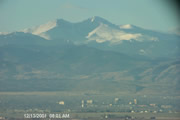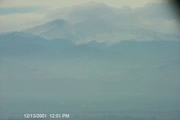Visibility#
"Visibility" is a measure of how the air looks. It can be described as the maximum distance that an object can be perceived against a background sky. Visibility also can refer to the clarity of objects in the distance, middle or foreground. Visibility is unique among air pollution effects because it involves human perception and judgment.

Clear Day

Poor Visibility
-
Along the Front Range, visibility impairment is caused primarily by fine particles (0.1 - 2.5 microns in diameter). Particles this size either scatter or absorb light coming from an object. Sulfates, nitrates, and elemental and organic carbon are most effective at scattering or absorbing light. Human-caused sources of these particles include woodburning, emissions from cars, trucks, and buses, soot from burning fields, and electric power generation. Visibility is also degraded by secondary aerosols, which are tiny gas and/or liquid droplets that are formed by chemical reactions between sulfate or nitrate and ammonia. Ground level ozone, which contributes to haziness in high concentrations, is formed when nitrogen oxides and volatile organic carbons (from motor vehicles and industry) combine with sunlight.
-
The visual quality of the air affects human welfare. Consequently, loss in visual quality may result in economic loss as the area becomes less attractive to residents, potential newcomers and industries. There is increasing information that shows a link between respiratory illness and fine particles, which also contribute to visibility impairment.
-
Yes, the State of Colorado has enacted a visibility standard based upon the visual preferences of Denver residents. However, the standard applies to all communities along the Front Range that are part of the AIR (Automobile Inspection and Readjustment) area. The visibility standard is .076 per kilometer of atmospheric extinction, which means that 7.6% of light in a kilometer of air is blocked. The standard applies between the hours of 8:00 a.m. and 4:00 p.m., and only when the relative humidity is less than 70 percent.
-
Visibility has been measured in Fort Collins since October 1993 by a transmissometer (a device which measures the amount of light attenuated by particles and gases in the air). Visibility levels are reported in the Fort Collins Air Quality Trends Reports. Since 1993, Fort Collins exceeded the State visibility standard approximately one-in-four days.
-
Although the state standard provides guidance for Front Range cities, there are no consequences for violating the standard. However, Fort Collins is working together with the County and State to reduce air pollution sources that contribute to visibility degradation. These efforts are focusing on reduction of Vehicles Miles of Travel (VMTs) and the reduction of per-mile tailpipe emissions. SMARTTrips is a public program whose goal it is to reduce Northern Front Range automobile dependency and promote the use of alternative transportation. More detailed information about sources and the fate of visibility reducing fine particles has been collected and is being analyzed in the North Front Range Air Quality Study.